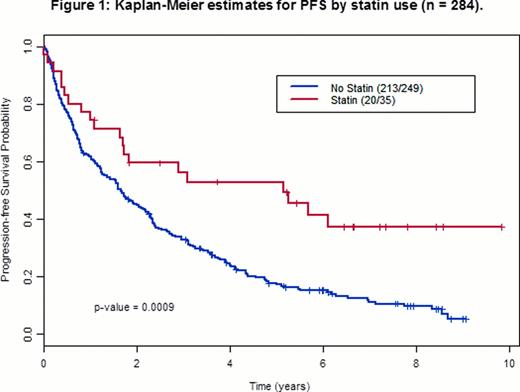Abstract
Abstract 3931
Statins are a class of drugs used to lower cholesterol levels by inhibiting the enzyme HMG-CoA reductase. In addition, statins possess anti-inflammatory, immunomodulatory, antioxidant, and cell growth inhibitory properties. In B- CLL cells, statins induce in-vitro apoptosis (Daphne Chapman-Shimshon et-al), suggesting that statins might possess properties. We noticed a high prevalence of dyslipidemia in patients with chronic lymphocytic leukemia (CLL). However the impact of dyslipidemia and its modulation by statins on clinical outcomes of patients with CLL remains unclear. Therefore, we conducted a retrospective analysis to assess the effect of statins in patients with CLL who received salvage (fludarabine, cyclophosphamide and rituximab) FCR chemotherapy.
We analyzed the clinical outcome of relapsed/refractory patients with CLL (n=284) who underwent FCR salvage therapy at our institution between 1999 and 2012. Patients who were uninterruptedly treated with statins at least one month prior to and during salvage therapy (n=35) were assigned to the statins arm, whereas the other arm consisted of 249 patients who were not treated with statins. The Cox proportional hazards regression model was used to assess the association between patient characteristics and progression-free survival (PFS) and overall survival (OS). Actual survival and PFS were estimated using the method of Kaplan-Meier, and OS and PFS were compared among two groups of patients using log-rank test.
All pretreatment characteristics of the patients with concurrent use of statins were similar to those who were not treated with statins except for their age. Patients in the statins arm were older: 21 patients (60%) were older than 65 compared to 74 patients of 249 (30%) in the other group (p<0.05).
The median OS and PFS of all 284 patients were 3.9 years (95% CI: 3.4–4.5) and 1.74 years (95% CI: 1.6–2.3), respectively. PFS was significantly longer in patients treated with statins. Fifteen of the 35 statin-treated patients (43%) as opposed to only 36 of 249 (14%) in the non-statins group experience no disease progression. Concurrent use of statins significantly prolonged PFS. The median PFS for statin-treated v/s. untreated was 4.6 and 1.7 years, respectively (p<0.05). This significantly improved PFS was consistent in young and elderly patients. In young patients (age < 65) with statins, the median PFS was not reached whereas in patients who were not treated with statins it was 2 years (p<0.05). In older patients (age ≥ 65), PFS was significant longer with concurrent use of statins than without statins; estimated PFS were 2 and 1.6 years, respectively (p<0.05).
With the median follow-up of 5 years, the median overall survival was significantly longer in patients treated with statins, with 17 of 35 (49%) patients of the statins group and 59 (24%) of 249 in patients who were not treated with statins alive at the end of study. Concurrent use of statins significantly prolonged OS with an estimated median OS for the two groups of 6.9 years and 3.9 years, respectively (p<0.05). This significantly improved OS was consistent in young and elderly patients. Young patients (age <65) with statins had a significant prolonged survival with an estimated OS of 8.6 years whereas estimated OS in young patients without statins (p<0.05) was only 4 years. In older patients (age ≥65) the median OS was significantly longer with the concurrent use of statins than without statins; estimated OS in the two subgroups were 6.9 and 2.6 years respectively, (p<0.05).
In conclusion, concurrent use of statins significantly improved OS, PFS in relapsed/refractory CLL patients treated with salvage FCR therapy. Further studies to determine the role of statins and mechanism of action in patients with CLL are warranted.
No relevant conflicts of interest to declare.
Author notes
Asterisk with author names denotes non-ASH members.



This feature is available to Subscribers Only
Sign In or Create an Account Close Modal